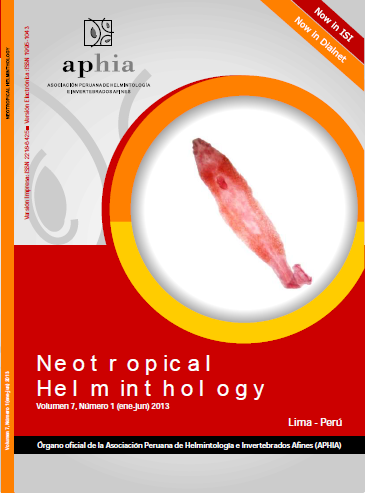MOLECULAR ANALYSIS AND BIODIVERSITY OF METAZOAN PARASITES OF THE YELLOWTAIL LAMBARI, ASTYANAXAFF. BIMACULATUS (TELEOSTEI, CHARACIDAE), IN LOWER SAN FRANCISCO, NORTHEASTERN BRAZIL
DOI:
https://doi.org/10.24039/rnh201371947Keywords:
Astyanax aff. bimaculatus, Brazil, Geneticdiversity, Ichthyoparasitology, Natural environmentAbstract
The difficulty in identifying some species of Lambaris comes from very similar phenotypic feature that often result from hybridization. The parasites can be indicative of various aspects of the biology of their hosts, including phylogeny, because some groups of parasites may have host specificity. The objective was to evaluate the genetic diversity and parasitology of the fish Astyanaxaff.bimaculatus. in ponds and streams adjacent to fish farms located in the Lower São Francisco, Sergipe, Brazil. The specimens were collected in the municipalities of Propriá and Neópolis and necropsied in the search for metazoan parasites. Sections of muscle tissue were taken for DNAextraction. The samples were subjected to PCR and electrophoresis with the products of the reactions. Subsequent cluster analysis was performed. Atotal of 102 fish were infected with Lernaeacyprinaceaand Dolopssp. on the body surface, Urocleidoidessp. and metacercariae of Echinostomatidae in gills, Prosthenhysteraobesain the gallbladder, Diplostomidae type Neascusin the swim bladder and the nematodes Procamallanushilariiand Rabdochonasp. in the gut. The genomic material of Astyanaxaff. bimaculatuswere evaluated with by origin: 34.3% from Propriá and 65.7% from Neopolis. Approximately 41% of the fish collected showed a homogeneous electrophoretic profile by using the primer CCCGTAGCAC. Among the specimens from Propriá, the genomic material presented electrophoretic profile with bands 800pb and >800pb. The last profile was more prevalent in hosts with Echinostomatidae in gills. Cluster analysis yielded a phylogenetic tree with two branches / groups, independent of the place of origin. However, it was homogeneous with respect to the expression of the character susceptibility / resistance to parasitic infection. These strategies can help in molecular taxonomic identification of Astyanaxaff. bimaculatus, which is difficult because of the great similarity in external morphology.
Downloads
Published
How to Cite
Issue
Section
License
Copyright (c) 2021 Neotropical Helminthology

This work is licensed under a Creative Commons Attribution-NonCommercial-NoDerivatives 4.0 International License.
OBJETO: El AUTOR-CEDENTE transfiere de manera TOTAL Y SIN LIMITACIÓN alguna al CESIONARIO los derechos patrimoniales que le corresponden sobre la (s) obra(s) tituladas: xxxxxxxxxxxxxxxx, por el tiempo que establezca la ley internacional. En virtud de lo anterior, se entiende que el CESIONARIO adquiere el derecho de reproducción en todas sus modalidades, incluso para inclusión audiovisual; el derecho de transformación o adaptación, comunicación pública, traducción, distribución y, en general, cualquier tipo de explotación que de las obras se pueda realizar por cualquier medio conocido o por conocer en el territorio nacional o internacional.
REMUNERACIÓN: La cesión de los derechos patrimoniales de autor que mediante este contrato se hace será a título gratuito.
CONDICIONES Y LEGITIMIDAD DE LOS DERECHOS: El AUTOR-CEDENTE garantiza que es propietario integral de los derechos de explotación de la(s) obra(s) y en consecuencia garantiza que puede contratar y transferir los derechos aquí cedidos sin ningún tipo de limitación por no tener ningún tipo de gravamen, limitación o disposición. En todo caso, responderá por cualquier reclamo que en materia de derecho de autor se pueda presentar, exonerando de cualquier responsabilidad al CESIONARIO.
LICENCIA DE ACCESO ABIERTO: El AUTOR-CEDENTE autoriza que manuscrito publicado en La Revista Neotropical Helminthology permanece disponible para su consulta pública en el sitio web https://www.neotropicalhelminthology.com/ y en los diferentes sistemas de indexación y bases de datos en las que la revista tiene visibilidad, bajo la licencia Creative Commons, en la modalidad Reconocimiento-No comercial- Sin Trabajos derivados –aprobada en Perú, y por lo tanto son de acceso abierto. De ahí que los autores dan, sin derecho a retribución económica, a la Asociación Peruana de Helmintología e Invertebrados Afines (APHIA), los derechos de autor para la edición y reproducción a través de diferentes medios de difusión.


 Numero 2 Volumen 19 - 2025 (versión Anticipada)
Numero 2 Volumen 19 - 2025 (versión Anticipada)














































